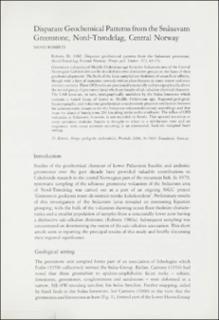Disparate geochemical patterns from Snåsavatn greenstone, Nord-Trøndelag, Central Norway.
Journal article

Åpne
Permanent lenke
https://hdl.handle.net/11250/2675132Utgivelsesdato
1982Metadata
Vis full innførselSamlinger
- Artikler [1064]
Sammendrag
Greenstone volcanites of Middle Ordovician age from the Snåsavatn area of the Central Norwegian Caledonides can be divided into two distinctive groups on the basis of their geochemical patterns. The bulk of the lavas sampled are tholeiites of ocean floor affinity, though with a hint of transition towards within-plate features in some minor and trace element contents. These OFB rocks are positioned structurally and stratigraphically above the second group of greenstone lavas which are basalts of calc-alkaline chemical character. The CAB lavas are, in turn, stratigraphically underlain by the Snåsa limestone which contains a varied fauna of Lower to Middle Ordovician age. Regional-geological, biostratigraphic and volcanite-geochemical considerations pinpoint similarities between the palaetectonic situations for the Snåsavatn volcanosedimentary assemblage and that from the island of Smøla some 200 km along strike to the southwest. The influx of OFB volcanites at Snåsavatn, however, is not recorded on Smøla. This upward transition to more primitive tholeiitic basalts is thought to relate to subduction zone and arc migration, with ocean accretion occurring in an extensional, back-arc marginal basin setting.
